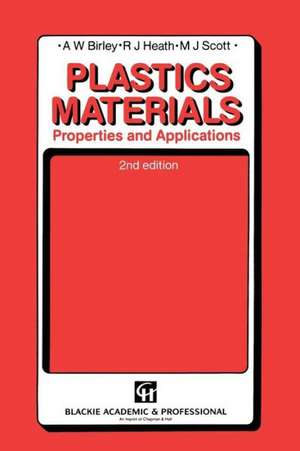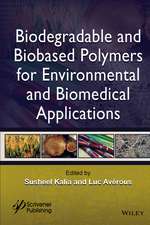Plastic Materials: Properties and Applications
Editat de Birleyen Limba Engleză Paperback – oct 1991
Preț: 382.75 lei
Nou
Puncte Express: 574
Preț estimativ în valută:
73.24€ • 76.62$ • 60.84£
73.24€ • 76.62$ • 60.84£
Carte tipărită la comandă
Livrare economică 02-16 aprilie
Preluare comenzi: 021 569.72.76
Specificații
ISBN-13: 9780751401622
ISBN-10: 0751401625
Pagini: 198
Ilustrații: X, 198 p. 85 illus.
Dimensiuni: 152 x 229 x 11 mm
Greutate: 0.29 kg
Ediția:1988
Editura: SPRINGER NETHERLANDS
Colecția Springer
Locul publicării:Dordrecht, Netherlands
ISBN-10: 0751401625
Pagini: 198
Ilustrații: X, 198 p. 85 illus.
Dimensiuni: 152 x 229 x 11 mm
Greutate: 0.29 kg
Ediția:1988
Editura: SPRINGER NETHERLANDS
Colecția Springer
Locul publicării:Dordrecht, Netherlands
Public țintă
ResearchCuprins
1 Introduction.- 1.1 Background.- 1.2 Structure and properties of plastics.- 1.3 Additives.- 1.4 Processing of plastics.- 1.5 Practical methods of processing.- 1.6 Interactions between shaping process and plastics materials.- Further reading.- 2 Fundamentals of design.- 2.1 Engineering design.- 2.2 Design limitations imposed by processing method.- 2.3 Product design.- 2.4 Importance of economics of processing in design.- Further reading.- 3 Styrene plastics.- 3.1 Polystyrene.- 3.2 High impact polystyrene.- 3.3 Styrene copolymers.- 3.4 ABS plastics.- 3.5 Polystyrene—poly(phenylene oxide) blends.- 4 Other amorphous thermoplastics.- 4.1 Poly(methyl methacrylate).- 4.2 Cellulose plastics.- 4.3 Polycarbonates.- 5 Propylene plastics.- 5.1 Homopolymer and impact-modified grades.- 5.2 Filled polypropylene.- 5.3 Foamed polypropylene.- 5.4 Miscellaneous applications of propylene polymers.- 6 Other polyolefin plastics.- 6.1 Polyethylene.- 6.2 Ethylene copolymers.- 6.3 Polybut-1-ene.- 6.4 Poly-4-methylpent-1-ene.- 7 Other crystalline thermoplastics.- 7.1 Polyamides.- 7.2 Thermoplastic polyesters.- 7.3 Polyacetals.- 8 Vinyl chloride plastics.- 8.1 Unplasticized poly(vinyl chloride).- 8.2 Plasticized poly(vinyl chloride).- 8.3 Vinyl chloride copolymers.- 8.4 Blends of poly(vinyl chloride).- 8.5 Vinylidene chloride polymers and copolymers.- 9 Speciality thermoplastics.- 9.1 Fluoroplastics.- 9.2 Polysulphones.- 9.3 Poly(phenylene sulphide).- 10 Cross-linked plastics.- 10.1 Introduction.- 10.2 Phenol-formaldehyde plastics.- 10.3 Urea-formaldehyde plastics.- 10.4 Melamine-formaldehyde plastics.- 10.5 Unsaturated polyester resins.- 10.6 Epoxide resins.- 11 Polyurethane plastics.- 11.1 Introduction.- 11.2 Molecular structure—property relationships.- 11.3 Properties and applications ofpolyurethanes.- Further reading.








